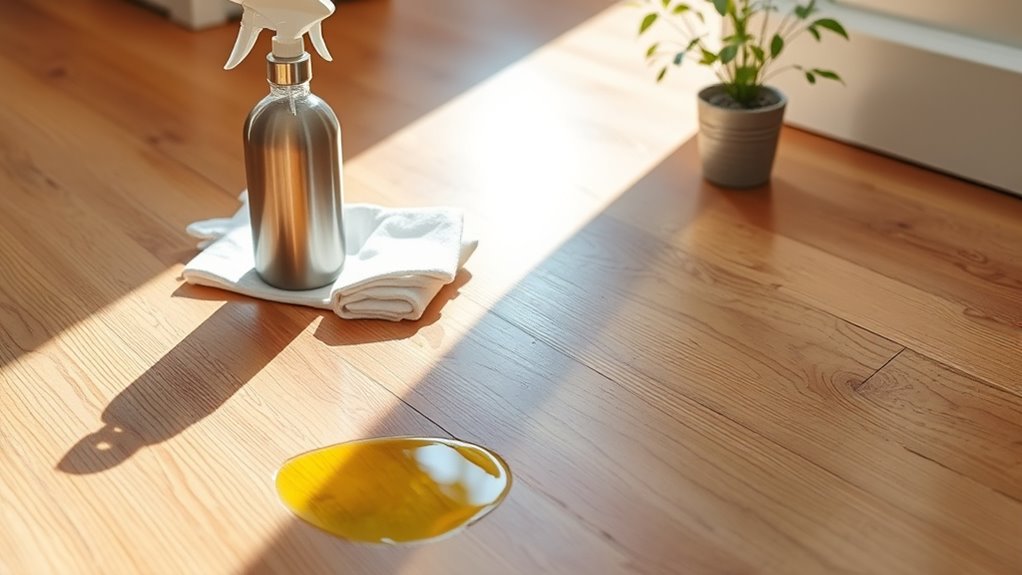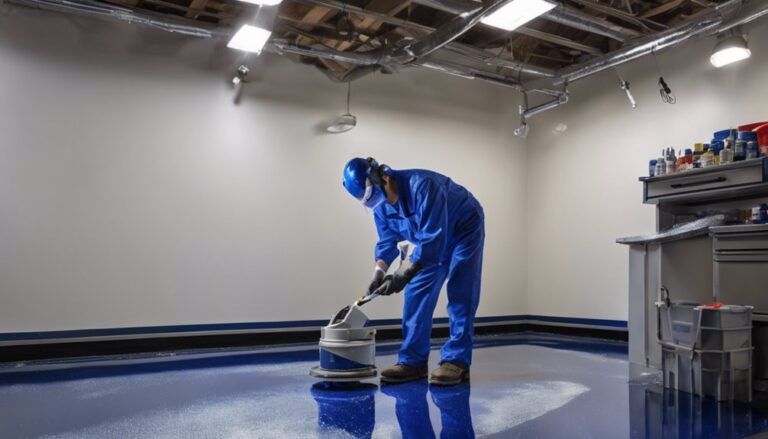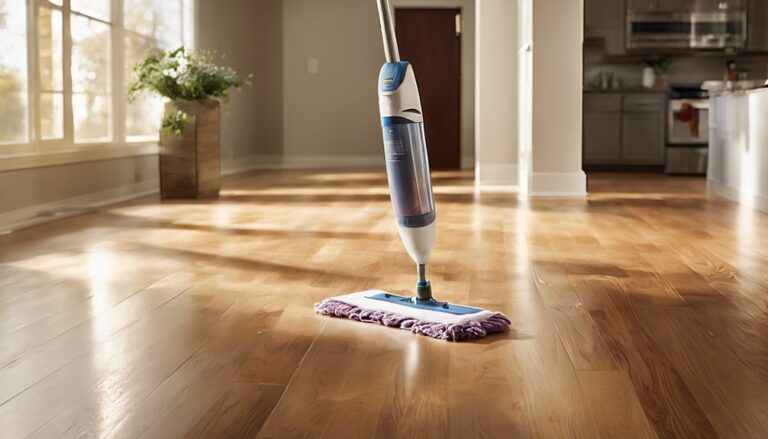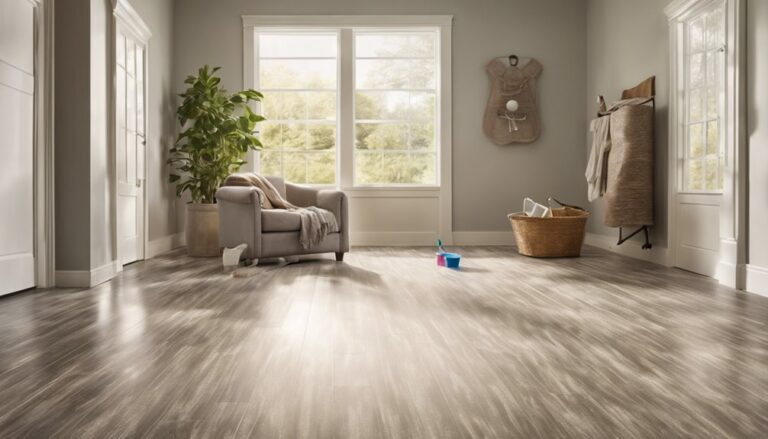To get pee stains out of hardwood floors, first blot the area gently to soak up moisture without rubbing. Mix one part white vinegar with two parts water, apply it with a soft cloth, and let it sit briefly before wiping dry. Sprinkle baking soda afterward to neutralize odors. Avoid harsh scrubbing to protect the wood’s finish. Using specialty hardwood cleaners can help if stains persist. Below, you’ll find steps to prevent future stains and keep your floors in top shape.
Identifying the Type of Hardwood Finish
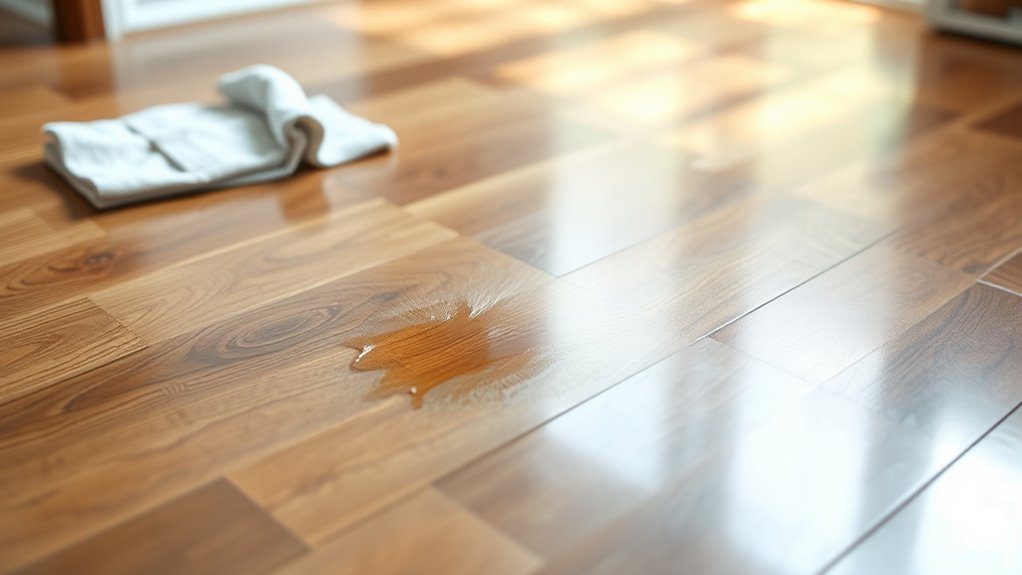
Before you tackle those pee stains, you need to know what kind of finish your hardwood piso has. Hardwood finish types vary—common ones include polyurethane, wax, and oil-based finishes. Identifying finishes is essential because each reacts differently to cleaning methods. To identify your floor’s finish, try a simple test: apply a few drops of water on an inconspicuous spot. If the water beads up, your finish is likely polyurethane or varnish. If it soaks in, it could be an oil or wax finish. You can also inspect the floor’s sheen; a glossy surface often indicates polyurethane, while a matte look suggests oil-based finishes. Knowing your floor’s finish lets you choose the right cleaning approach without damaging the wood, giving you the freedom to restore your floor safely.
Immediate Steps to Take After a Pee Accident
The first and most important step after a pee accident is to act quickly to prevent the stain and odor from setting into your hardwood floor. Start by blotting the area with a clean, absorbent cloth or paper towel—don’t rub, as that can push the urine deeper. Next, use appropriate cleaning products designed for hardwood floors to lift the stain and neutralize odors. Avoid harsh chemicals that can damage the finish. Promptly removing moisture also helps with stain prevention and protects the wood from warping. Make certain the area dries completely by increasing ventilation or using a fan. Taking these immediate steps not only preserves your floor’s appearance but also gives you the freedom to enjoy your space without worrying about lingering stains or smells.
Using Vinegar and Water Solution for Cleaning
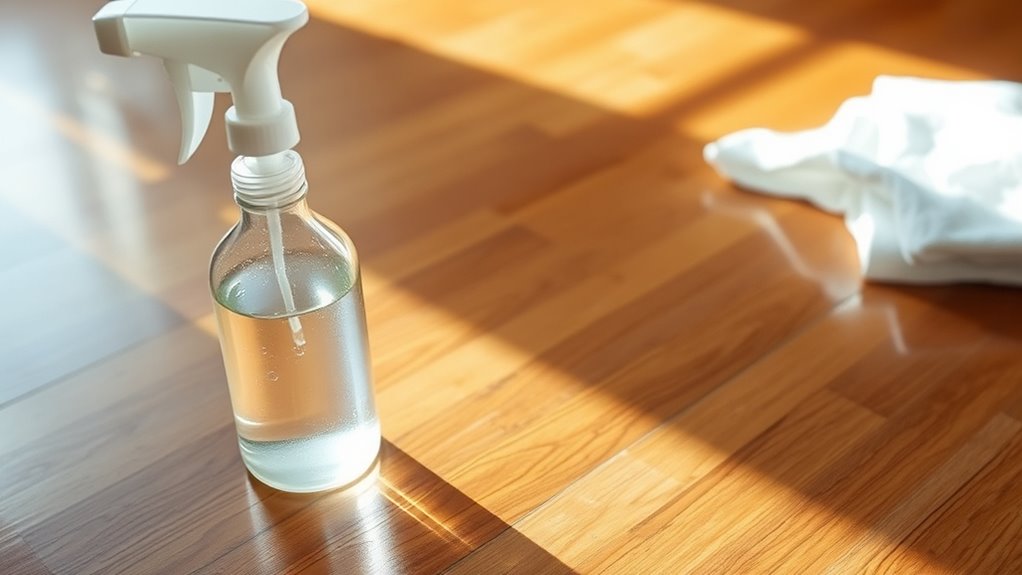
Although vinegar might seem like a simple household item, it’s highly effective for cleaning pee stains on hardwood floors without causing damage. You’ll appreciate vinegar benefits such as its natural disinfectant properties and ability to break down urine stains without harsh chemicals. To get started, mix one part white vinegar with two parts water; this water ratio balances cleaning power with floor safety. Apply the solution gently using a soft cloth or spray bottle, ensuring the area is saturated but not soaked. Let it sit for 5-10 minutes to allow the vinegar to penetrate and neutralize the stain. Finally, wipe the floor dry with a clean, dry cloth to prevent moisture damage. This method keeps your hardwood clean while preserving its finish and your freedom from tough chemicals.
Applying Baking Soda to Neutralize Odors
You’ll find baking soda is a natural and effective way to neutralize odors from pee stains on hardwood floors. To apply it, sprinkle a generous layer over the affected area and let it sit for several hours to absorb the smell. This process helps eliminate odors without damaging your floor’s finish.
Benefits of Baking Soda
When pet urine leaves behind odors, applying baking soda can effectively neutralize them without harsh chemicals. Baking soda benefits include its ability to act as a natural odor remover, making it a safe and eco-friendly choice for your hardwood floors. By using baking soda, you avoid synthetic fragrances and toxic substances, preserving indoor air quality and your freedom from chemical exposure. Its versatility also means you can trust it in various cleaning scenarios beyond pet accidents. Here are key benefits of baking soda:
- Neutralizes acidic and alkaline urine odors naturally
- Safe for pets and children around your home
- Non-abrasive, protecting your hardwood finish
- Inexpensive and easily accessible
- Biodegradable and environmentally friendly
Embracing baking soda lets you maintain a fresh, healthy living space with minimal effort.
Técnicas de aplicación
Since effectively applying baking soda is key to neutralizing odors, you should start by thoroughly cleaning the area to remove any excess urine. Once the floor is dry, sprinkle a generous layer of baking soda directly onto the stain. Make certain to cover the entire affected spot to maximize stain removal. Let the baking soda sit for several hours or overnight to absorb moisture and odors. For tougher stains, you can mix baking soda with a small amount of water to create a paste, then gently rub it onto the stain using a soft cloth. Avoid harsh scrubbing to protect your hardwood. After the baking soda has done its job, vacuum or sweep it up carefully. Using baking soda alongside other cleaning solutions guarantees a fresh, stain-free floor and restores your freedom from lingering odors.
Odor Neutralization Process
After applying baking soda to the stain, the next step focuses on how it neutralizes odors effectively. Baking soda works through odor absorption, trapping unpleasant smells within its porous structure. Here’s what you need to know:
- Baking soda’s alkaline nature breaks down acidic urine molecules.
- It prevents odors from lingering by absorbing moisture and odor particles.
- Let it sit for several hours or overnight for maximum effect.
- Afterward, vacuum or sweep up the powder thoroughly.
- For stubborn odors, follow up with enzyme cleaners that break down organic residues.
Using baking soda combined with enzyme cleaners guarantees you’re not just masking the smell but eliminating the source. This process helps maintain your hardwood floors’ freshness without harsh chemicals, giving you the freedom to enjoy a clean, odor-free home.
Gentle Scrubbing Techniques to Avoid Damage
To protect your hardwood floors, use soft cleaning tools like microfiber cloths or sponges when scrubbing. Apply gentle pressure to avoid scratching or wearing down the finish. This careful approach guarantees effective stain removal without causing damage.
Choosing Soft Cleaning Tools
Although hardwood floors are durable, you’ll want to use soft cleaning tools to prevent scratches or damage while removing pee stains. Choosing the right tools guarantees effective cleaning without compromising your floor’s finish.
Consider these options to keep your hardwood safe:
- Soft brushes: gentle on wood grains, ideal for loosening debris.
- Microfiber cloths: excellent for absorbing moisture and lifting stains.
- Non-abrasive sponges: avoid rough textures that can scratch.
- Soft cotton towels: useful for blotting without rubbing harshly.
- Plastic or rubber scrapers: for carefully removing dried residue without gouging.
Proper Pressure Application
Apply just enough pressure when scrubbing to lift the pee stain without damaging the wood’s surface. Using the proper pressure is essential to protect your hardwood floors while effectively removing stains. Too much force can scratch or dull the finish, while too little won’t clean thoroughly. Start with gentle, circular motions using a soft cloth or sponge. Gradually increase pressure only if the stain resists. This cleaning technique guarantees you break down the stain without compromising the wood’s integrity. Remember, consistency beats intensity—steady, controlled scrubbing is your best bet. By mastering proper pressure application, you maintain your floor’s natural beauty and extend its life. This method gives you freedom to clean confidently without fear of damage.
When to Use Commercial Hardwood Floor Cleaners
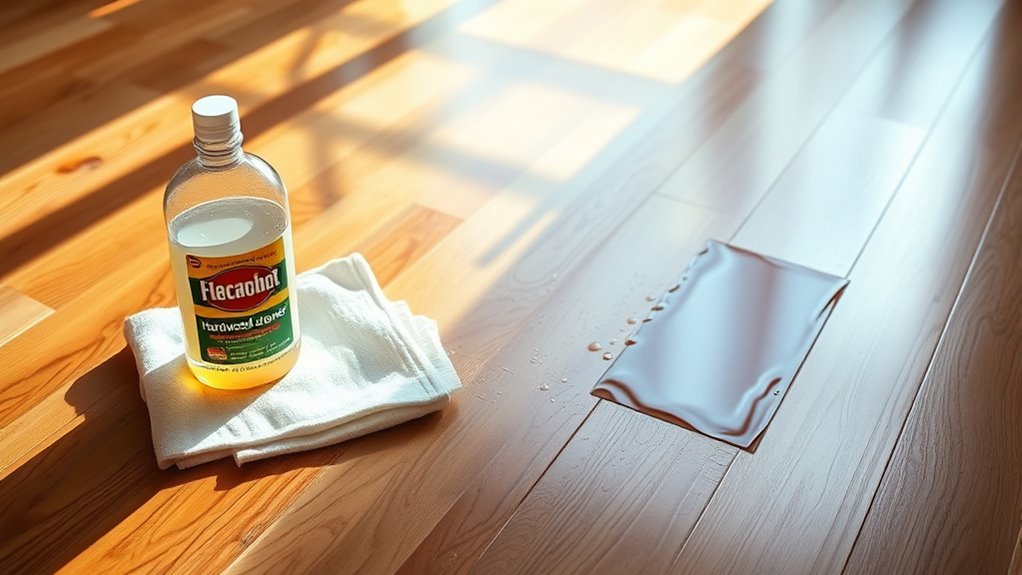
If you’ve tried home remedies and the pee stains on your hardwood floors still linger, it may be time to contemplate commercial hardwood floor cleaners. These products are designed for tough stains and can complement your hardwood maintenance routine. You should consider commercial cleaners when:
- Stains penetrate deep into the wood grain
- Home solutions fail after multiple attempts
- You notice discoloration or odor persists
- Your floor finish can tolerate stronger chemicals
- You want a product tested for hardwood care
When choosing a commercial cleaner, always check that it’s safe for hardwood and follow the instructions carefully. Using the right product at the right time guarantees you protect your floors while effectively removing stains, giving you freedom from stubborn marks without compromising your wood’s longevity.
Preventing Future Pee Stains on Hardwood Floors
To keep your hardwood floors looking their best, preventing future pee stains is just as important as cleaning existing ones. Start by implementing preventive measures, such as placing washable mats or rugs in high-risk areas. Consistent pet training is key—establish a regular bathroom routine and reward good behavior to reduce accidents. Make sure your pets have easy access to outdoor spaces or designated potty areas. Clean any accidents immediately to discourage repeat offenses. Using enzymatic cleaners during training helps eliminate odors that attract pets back to the same spot. By combining these strategies, you maintain your floors’ integrity and enjoy the freedom of a clean, stain-free space. Taking proactive steps now saves you time and effort in the long run.

